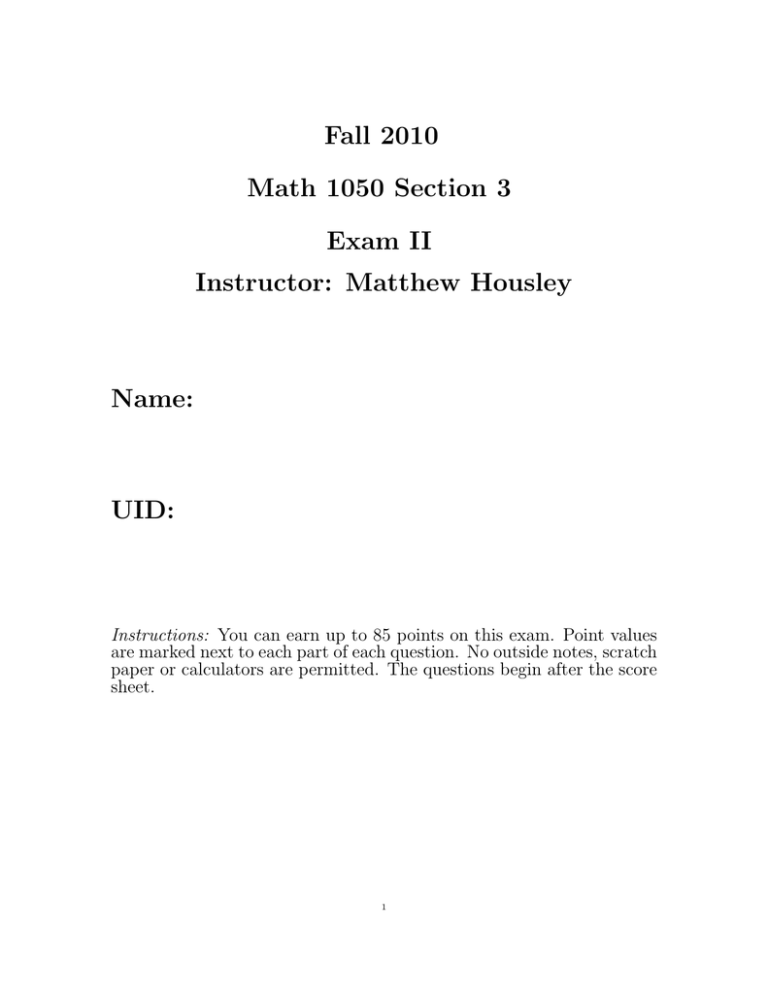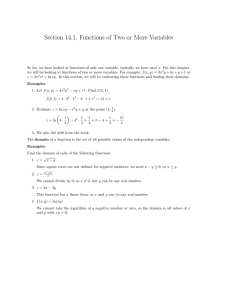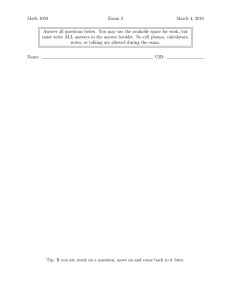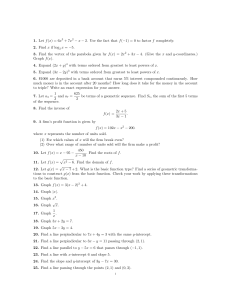Fall 2010 Math 1050 Section 3 Exam II Instructor: Matthew Housley
advertisement

Fall 2010 Math 1050 Section 3 Exam II Instructor: Matthew Housley Name: UID: Instructions: You can earn up to 85 points on this exam. Point values are marked next to each part of each question. No outside notes, scratch paper or calculators are permitted. The questions begin after the score sheet. 1 Score Sheet: 1. 2. 3. 4. 5. 6. 7. 8. 9. 10. 11. 12. 13. 14. 15. Total: 2 1. Describe the end behavior of the following polynomials: what happens as x goes to +∞ and −∞? (4 points.) (1) −x7 + 4x3 + 3x2 − 8 (2) 3x18 + 3x4 − 12x3 + x − 18 2. f (x) = (x − 3)4 (3x + 4)3 (x − 8)5 What are the roots of f ? At each root, determine whether or not the graph of f crosses the x-axis. Put the zeros of f on a number line and indicate the regions where f is positive and negative. (6 points.) 3 3. Evaluate 5x5 − 36x4 + 9x3 − 12x2 − 15x + 15 at x = 7 by using synthetic division. Your answer should be between 0 and 10. (6 points.) 4 4. Find all the roots of f (x) = x4 − 4x3 + 3x2 + 2x − 6 given √ that 3 and −1 are roots. Simplify the roots by pulling squares out of square roots and replacing −1 with i. (8 points.) 5 5. Compute (x4 − 4x3 + 3x2 + 2x − 6) ÷ (x3 − 11) by long division. Make sure to label your remainder. (5 points.) 6. Rewrite 5 + 2i in standard form i.e., in the form a + bi. You will get fractions for a and b. (4 1 − 3i points.) 6 7. Let f (x) = 14x5 − 5x4 + 8x2 + 2x − 3. List all the possible rational roots of f according to the rational root theorem. Do not attempt to factor f . (4 points.) 8. (3 − 2i) is a root of f (x) = x5 − 14x4 + 66x3 − 142x2 + 113x − 104. What is another root of f (x)? (4 points.) 7 9. Use the rational root theorem to find a root of g(x) = 2x3 + 9x2 + 4x − 15 between 0 and 3, then find the other roots of g. Write g as a product of linear factors. (8 points.) 8 10. Use Descarte’s rule of signs to determine how many positive and negative real zeros f (x) = x5 + 3x3 − 3x2 + 8x − 3 can have. (4 points.) 11. (8 points.) Find the horizontal asymptotes, vertical asymptotes and roots of h(x) = 3x2 − x − 2 . 2x2 + 7x + 3 9 12. (4 points.) Simplify log2 128. 13. Rewrite log4 81 in terms of the natural logarithm. (4 points.) 10 14. Use the properties of the logarithm to expand the following expression as a sum, difference, and/or constant multiple of logarithms: (8 points.) 8x2 log5 √ , x > 1. 5x − 3 15. Condense the expression to the logarithm of a single quantity: (8 points.) ln 3 + 3 ln(x − 5) − ln(x). 11






![Homework 12: Due Wednesday 7/9/14 on the interval [−1, 2]?](http://s2.studylib.net/store/data/011229144_1-0554531fc36f41436ee2a5dab6cfe618-300x300.png)